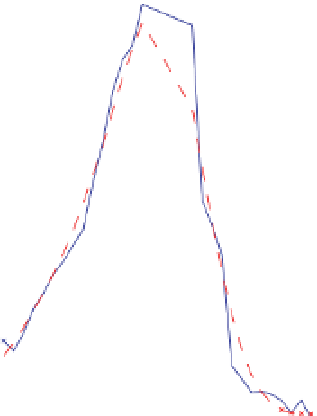Geoscience Reference
In-Depth Information
Inverted volumetric current density
Least square inversion result for 145.375 s
×
10
-4
Well
0
−10
4
0.2
−11
0.4
2
−12
0.6
−13
0
0.8
1
−14
−2
1.2
−15
−4
1.4
−16
1.6
−6
Measured
Predicted
−17
1.8
−8
−18
2
7.0
7.5
8.0
8.5
9.0
9.5
10
7.0
7.5
8.0
8.5
9.0
9.5
10
Distance (m)
Distance (m)
(a)
(b)
Figure 5.46
Source localization of a single snapshot at time 145.38 s the localization of the self-potential anomaly (positive pole
associated with the pulse injection) is located very close to the end of the open well. The electrical resistivity has been accounted
for this inversion. Results shown are at the third iteration. (
See insert for color representation of the figure
.)
5.6 Conclusions
the seismic source (type I disturbance). Therefore, the
record of the electrical disturbances of electrokinetic
origin in addition to the seismic information can gener-
ate a clear advantage in localizing hydraulic fracturing
events in time and space and characterizing the associ-
ated moment tensor. We have also used a deterministic
algorithm to invert the electrical data alone. Assuming
the resistivity model is known, this algorithm is used
to retrieve the position of the seismic source and the
position of any heterogeneity within the model domain.
Then, the moment tensor is successfully inverted using
the AMA.
Two important observations have come from the
experimental data presented in Section 5.3. First, bore-
hole seal failure during hydraulic fracturing generated
electrical current densities and measurable electrical
potentials when fracturing fluid flowed into the annulus
between the wall of the well and the casing and came in
contact with the borehole wall. Second, we have shown
that the source current density associated with the seal
leak can be located using a self-potential tomography
technique.
We have developed a framework for the forward
modeling of seismograms and electrograms associated
with a localized hydromechanical disturbance character-
ized by a moment tensor. The numerical propagation of
seismic waves and associated electrical disturbances are
done with the finite-element approach in the frequency
domain. The forward model couples Biot theory with an
electrokinetic model based on the excess of electrical
charges per unit pore water. We looked at the value
of the information content of the electrical data with
respect to the seismic data to see the value of performing
a full waveform joint inversion with both types of data.
The inverse is performed using the AMA, an efficient
MCMC sampler. For noise-free data, the electrical data
contains, in principle, more information than the seis-
mic data. For noisy data, the joint inversion provides
better constraints for obtaining model parameters than
the inversion of the seismic data alone. One of the rea-
sons for this improvement is that the electrical informa-
tion can be used to estimate the time of occurrence of







































































































































































































































































